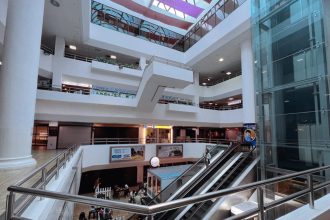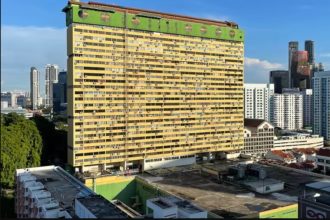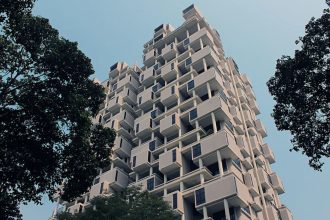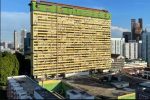Key takeaway
Gardens by the Bay grew from the reclaimed land once occupied by Marina City Park into a billion‑dollar green landmark. It was built to fulfil Singapore’s vision of transforming from a “Garden City” into a “City in a Garden”. Today, it’s three waterfront gardens, cooled conservatories, and iconic Supertrees symbolise how the city fused urban growth and nature into one living, breathing space.
Marina City Park once stood where Gardens by the Bay is now. It was a much-loved open space, but by 200,7 the park closed to make way for an ambitious, green reimagining. That marked the start of a massive transformation, turning 26 hectares of reclaimed land into what would become one of Singapore’s signature billion‑dollar landmarks.
The roots: Marina City Park to a green vision
Marina City Park opened in December 1990 on reclaimed land in Marina South. It stretched across roughly 26.2 hectares. The park featured open lawns, waterfront terraces, a two‑tiered pond, and a sculptural fountain that blasted water up to 18 metres high. There were also sculptures, contemporary ones like Soaring Vision and Spirit of Youth, and historical figures such as Chinese legendary heroes.
By 2005, Singapore was looking ahead. The government articulated a bold vision: evolve from “Garden City” to “City in a Garden.” That meant greening not only housing estates and parks, but the city’s core itself. Marina City Park was identified as a prime site for this transformation.
The billion‑dollar project takes shape
In 2006, the National Parks Board (NParks) launched an international competition for the design of Gardens by the Bay. Over 170 firms from 24 countries submitted proposals. Two UK firms won: Grant Associates for Bay South Garden, and Gustafson Porter for Bay East. Their master plans would eventually reshape 101 hectares of reclaimed land.
Construction officially kicked off when Marina City Park closed on 1 June 2007 to make way for the new gardens. The first phase was expected to be completed by end‑2010, focusing on the 54-hectare Bay South Garden.
Design: nature meets technology
Grant Associates designed Bay South Garden to showcase lush tropical horticulture, mass plantings, and bold floral displays. Wilkinson Eyre Architects, along with Atelier One and Atelier Ten, helped design the structural and climate systems for the conservatories.
Key features include:
- The Flower Dome, a 1.2‑hectare cooled conservatory replicating the cool‑dry climate of Mediterranean and semi‑arid regions.
- The Cloud Forest, covering about 0.8 hectares, with a misty, tropical mountain-like environment.
- Supertrees, the vertical garden structures ranging between 25 and 50 metres high, support climbers, ferns, and orchids.
- Sustainable systems: rainwater collection, environmental water basins, and shading strategies for energy efficiency.
Opening the Gardens: from plan to public space
Bay South Garden officially opened on 29 June 2012. By then, the conservatories were complete: the Flower Dome’s glass façade was capped in early 2011, and the Cloud Forest followed shortly.
The full Gardens by the Bay covers three waterfront gardens:
- Bay South Garden: the largest, at 54 ha.
- Bay East Garden: about 32 ha, with a 2‑km promenade along the Marina Reservoir. It also links visitors to Singapore’s largest reclaimed park.
- Bay Central Garden: 15 ha, connecting the other two gardens via a 3‑km waterfront promenade.
The cost, scale, and sustainability of Gardens by the Bay
The total approved construction budget for Gardens by the Bay was S$1.035 billion, not including land cost. That covered site works, soil improvement, drainage, access roads, and core infrastructure. Annual operating cost is about S$58 million, with S$28 million of that for the conservatories.
To manage cost, some design adjustments were made. For instance, the Supertrees were reduced from an original plan of 36 to 18. It shows how Singapore balanced ambition with fiscal discipline.
Gardens by the Bay: Where engineering and architecture come together
The structural engineering was led by Meinhardt Infrastructure, working with Atelier One and others. Their work made sure that the cool conservatories, Supertrees, and water systems were sound, safe, and efficient.
Grant Associates (landscape) and Wilkinson Eyre (architecture) integrated design and function seamlessly. The Supertrees are not just visually striking; they help in cooling, light up at night, and collect rainwater. Visitors often draw comparisons between Haw Par Villa and Gardens by the Bay when considering Singapore’s themed and experiential green spaces.
How people use the Gardens by the Bay today
Since its opening, Gardens by the Bay has become a hub for both locals and tourists. Visitors stroll along the waterfront promenades, attend concerts under the Supertrees, and walk inside the conservatories to experience climates from around the world.
The Gardens also host educational and community programmes, such as horticultural displays, cultural gardens, and heritage-themed plantings. The nearby Singapore’s 24km green corridor offers another way for people to connect with urban nature, showing how greenery threads through the city.
A comparison: past and present green space
| Site | Area / Key facts | Nearest MRT | Source |
|---|---|---|---|
| Marina City Park | 26.2 ha, opened 1990, demolished 2007 | — | — |
| Bay South Garden (Gardens by the Bay) | 54 ha, opened 2012, includes Flower Dome, Cloud Forest, 18 Supertrees | Gardens by the Bay MRT (TEL) | — |
| Entire Gardens by the Bay complex | 101 ha total across Bay South, Bay East (32 ha), and Bay Central (15 ha) | Gardens by the Bay MRT (TEL) | — |
Gardens by the Bay: Greening a city, building a future
The transformation from a modest reclaimed-land park into the sprawling, sophisticated Gardens by the Bay shows what happens when ambition meets care. This billion‑dollar project is not just about landscaping. It is a statement: Singapore will grow. But it will grow alive. Readers can also see more about Singapore’s urban greenery initiatives in Singapore through official resources.
Lessons from building this green billion‑dollar project
- Vision drives change: The “City in a Garden” idea provided a clear guiding star for the project.
- Smart design saves money: Cutting the number of Supertrees and tweaking the size of conservatories helped manage costs.
- Sustainable systems long-term: Rainwater collection and energy-efficient structures reduce running costs.
- People come first: The design includes spaces for rest, learning, and community events.
- Integration works: The Gardens link up to waterfront promenades and the MRT, making them accessible.
Quick facts about Gardens by the Bay
Gardens by the Bay is packed with features and details that make it unique. Here are some key points that help paint a clearer picture of its scale, diversity, and accessibility:
- The project was officially announced by Prime Minister Lee Hsien Loong in 2005, signalling Singapore’s ambition to transform its cityscape with greenery and public spaces.
- The Flower Dome, one of the two cooled conservatories, houses about 87,000 plants representing over 400 species from regions with a Mediterranean or semi-arid climate, offering visitors a diverse botanical experience.
- The Cloud Forest replicates a tropical mountain environment, featuring more than 130,000 plants from over 400 species, including rare orchids and ferns, with a dramatic 35-meter indoor waterfall that enhances the cool, misty atmosphere.
- The Supertrees, iconic vertical gardens ranging from 25 to 50 meters high, support over 162,900 plants from more than 200 species of climbers and epiphytes, creating a striking fusion of architecture and greenery that also functions for sustainability purposes like solar energy and rainwater collection.
- The nearest MRT station, Gardens by the Bay on the Thomson‑East Coast Line, opened in November 2022, improving accessibility and connecting the Gardens seamlessly with Singapore’s public transport network.
Gardens by the Bay: Singapore’s vision in bloom
Gardens by the Bay stands as proof that thoughtful urban planning can merge nature and city life. What began as a reclaimed plot with a modest park has grown into a landmark admired worldwide. It inspires both residents and visitors to see how urban growth and greenery can coexist. This project highlights Singapore’s commitment to sustainable, forward-looking design and how green spaces can shape not only the skyline but the way people experience the city. The Gardens also demonstrate how large-scale projects can be both functional and beautiful, offering spaces for recreation, education, and community engagement. As the city continues to evolve, Gardens by the Bay will remain a living example of what is possible when imagination, planning, and nature come together. Its ongoing programs and seasonal displays ensure that every visit offers something new, keeping the spirit of innovation alive for generations to come.








